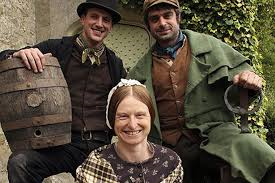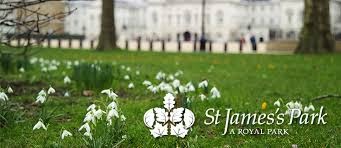On Sunday, September 5, 2014, the lucky participants in The Duke of Wellington Tour will take a walking tour (aka a leisurely stroll with many stops for refreshment) of part of London, principally through St. James’s. Victoria here, with a few facts and pictures.
St. James’s can mean a number of things in London, but generally it refers to a small neighborhood south of Mayfair and west of Whitehall and Trafalgar square, bounded by Piccadilly on the north, St James’s Park on the south, Green Park on the west and Haymarket on the east. St. James’s is a royal palace; a church on Piccadilly, designed by Sir Christopher Wren; a lovely park; an area known as clubland, and a street of distinguished shops.
The name comes from St. James’s Palace, so named because it was built on the site of a hospital for lepers dedicated to St. James the Less, one of the twelve Apostles. Here Henry VIII built the red brick structure which still serves as the official residence of the British monarch. Note that Ambassadors to Great Britain are officially designated as Ambassadors to the Court of St. James.
Main Entrance on Pall Mall
at the foot of St. James’s Street
The Tudor Entrance
Official events are held here and the Chapel Royal is often the venue for royal weddings and baptisms, such as the christening of Prince George of Cambridge on October 13, 2013.
Prince William, Duke of Cambridge, the Duchess of Cambridge
and Prince George of Cambridge at St James’s Palace for the Christening
The Altar, Chapel Royal, from The Mirror
St. James’s Palace is not open to the public, though it is possible to attend some Sunday worship services at the Chapel Royal from October to Good Friday.
Click here for details.
Caroline and George
The ill-fated wedding of George, Prince of Wales (later George IV) to Princess Caroline of Brunswick took place on April 8, 1795.
Albert and Queen Victoria
Queen Victoria married Prince Albert of Saxe-Coburg-Gotha on February 10, 1840 in the Chapel Royal. Eighteen years later, their daughter Victoria, The Princess Royal, married here as well, to the future German Emperor Frederick III.
The Marriage of George V and Princess Mary of Teck, July 6, 1893
Gardens at St. James’s, ca. 1700
According to the Garden Visit website (click here), the original renaissance garden, shown above, compartments, were re-designed in the “gardenesque style.”
18th Century Print: Cherries; a seller outside the Palace
St. James’s has often been the venue for Royal levees and receptions . This plate below from the Microcosm of London, 1810, shows a “Drawing Room,” where a chosen circle could present themselves and their friends and family formally to the Royals.
Ackermann’s Microcosm of London
On the Duke of Wellington Tour, we won’t be going inside, but we will see the Palace and its neighbors, The Queen’s Chapel, Marlborough House, Lancaster House, Clarence House, the Mall, St. James’s Street, and more. Below are a few pictures I took on a previous visit to St. James’s.
Palace from Marlborough Road
Palace from Marlborough Road
The Queens Chapel in Marlborough Road
Along the Mall, Trooping of the Colour, 2011
Marlborough House
St. James’s Church, Piccadilly
For all the Details about The Duke of Wellington Tour, click here.






















